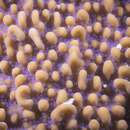Biology
provided by World Register of Marine Species
zooxanthellate
van der Land, J. (ed). (2008). UNESCO-IOC Register of Marine Organisms (URMO).
- license
- cc-by-4.0
- copyright
- WoRMS Editorial Board
Description
provided by World Register of Marine Species
Thick encrusting sheets or low massive forms, sometimes with leafy edges to the colony, but sometimes forming extensive, thin leaves. This species has a smooth looking surface, with large, rounded tuberculae 0.5 to 1.5 cm long, of irregular shape. Calices lie between the tuberculae. It is common on reef slopes from 5 to 25 m depth (Sheppard, 1998). Colonies are columns or plates with surfaces covered with tuberculae which are dome-shaped or fused into radiating ridges. Corallites are small, immersed, crowded between the tuberculae. Colour: usually pale brown with paler margins. Polyps are often brightly coloured. Abundance: common on upper reef slopes and lagoons (Veron, 1986). Generally encrusting or plate-forming, with bumps and ridges between polyps. Colour: pale brown with lighter margins; polyps may be brightly coloured but are not generally seen during the day. Habitat: lagoons and shallow reef slopes (Richmond, 1997).
Roux, J.P. (2001) Conspectus of Southern African Pteridophyta. Southern African Botanical Diversity Network Report 13 Page 118 (Includes a picture).
- license
- cc-by-4.0
- copyright
- WoRMS Editorial Board

